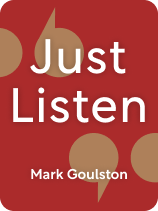

This article is an excerpt from the Shortform book guide to "Just Listen" by Mark Goulston. Shortform has the world's best summaries and analyses of books you should be reading.
Like this article? Sign up for a free trial here.
What does it mean to “listen to understand”? How do you suppress the tendency to come up with a reply, and instead, channel your energy to really understand what someone is saying?
As a popular adage goes, we should listen to understand, not to respond. However, most of us do the opposite: Instead of attempting to really understand the deeper meaning behind words, we try to come up with a response.
With this in mind, here’s how to listen to understand, according to psychiatrist Mark Goulston.
Understand the Other Person’s Perspective
When someone has ideas or emotions that are different from yours, don’t try to criticize their ideas or force your way of thinking on them. This will only motivate them to dig their heels in and solidify their stance. Instead, try to look at the world from the point of view of the person you’re trying to influence and understand why they believe what they do. In other words, listen to understand. This will make them feel less alone and less defensive—and as a result, they’ll be more likely to consider your ideas.
(Shortform note: In Leadership Strategy and Tactics, Jocko Willink emphasizes that understanding why someone disagrees with you will help you counter their points more effectively.)
If you’re trying to influence or cooperate with someone with whom you’re having a conflict of ideas, here are the steps Goulston says you should take to understand their perspective:
- Choose an emotion you think the other person is feeling.
- Tell the other person that you’re trying to understand what they’re feeling, and that you think it’s blank (anger, fear, frustration, and so on). Ask them if this is correct. If it’s not, ask them what they’re feeling. Clarify how strongly they feel this emotion.
- After they’ve vented about what they’re feeling, ask why they think they have this feeling. Here is where they will move past their emotion and start discussing the issue at hand.
- Finally, ask what needs to happen for this feeling and situation to improve. Ask what they can do to execute their plan. Ask what you can do to help.
(Shortform note: In an article published since this book was released, Goulston explains that to truly understand someone, you must get to know their personal capabilities, goals, and external circumstances. Doing this will not only help the other person feel appreciative of your awareness, but you’ll also be able to better accommodate their priorities and limitations when you convince them of an idea or offer solutions to their problems. To gather this information, keep these categories in mind as you engage in conversation.)
Now Ask Them to Understand You
After hearing the other person out, encourage them to imagine what you are thinking or feeling by using an analogy. Then, compare that analogy to the real issue and explain how whatever they’re doing makes you feel a similar way. For example, if you’re upset that someone struggles to offer you their attention while you’re talking with them, you could ask that person if they’d be upset with someone that’s constantly looking at their phone while they’re trying to talk to them. Then, you could explain that when they don’t offer you their attention, it makes you feel a similar way.
| If you’re unable to communicate your hurt feelings through the analogy alone, consider your approach. Experts say that to effectively communicate your feelings and move toward a solution, you should follow these three steps: Anticipate a positive outcome. When you believe that confronting someone will end poorly, you risk suppressing these emotions until they build up and cause you to lash out at the other person. On the other hand, believing that your conversation will be constructive will help you initiate the conversation and stay calm. Don’t blame the other person for the way you feel. By blaming the other person for the emotions you’re feeling, you’ll likely cause them to become defensive and closed off to hearing you out. Instead, simply state the emotion you’re experiencing. If the person cares about you, they’ll instinctually ask why you feel that way. When this happens, they’re opening up to you. Offer a solution. Instead of explaining what you’d like them to stop doing, explain what you’d like them to do differently. It’s less aggressive and will encourage them to consider how they can meet your request. |

———End of Preview———
Like what you just read? Read the rest of the world's best book summary and analysis of Mark Goulston's "Just Listen" at Shortform.
Here's what you'll find in our full Just Listen summary:
- Why listening is the most important step in influencing others
- How to overcome the most common obstacles to listening well
- How to break down someone’s emotional barrier






